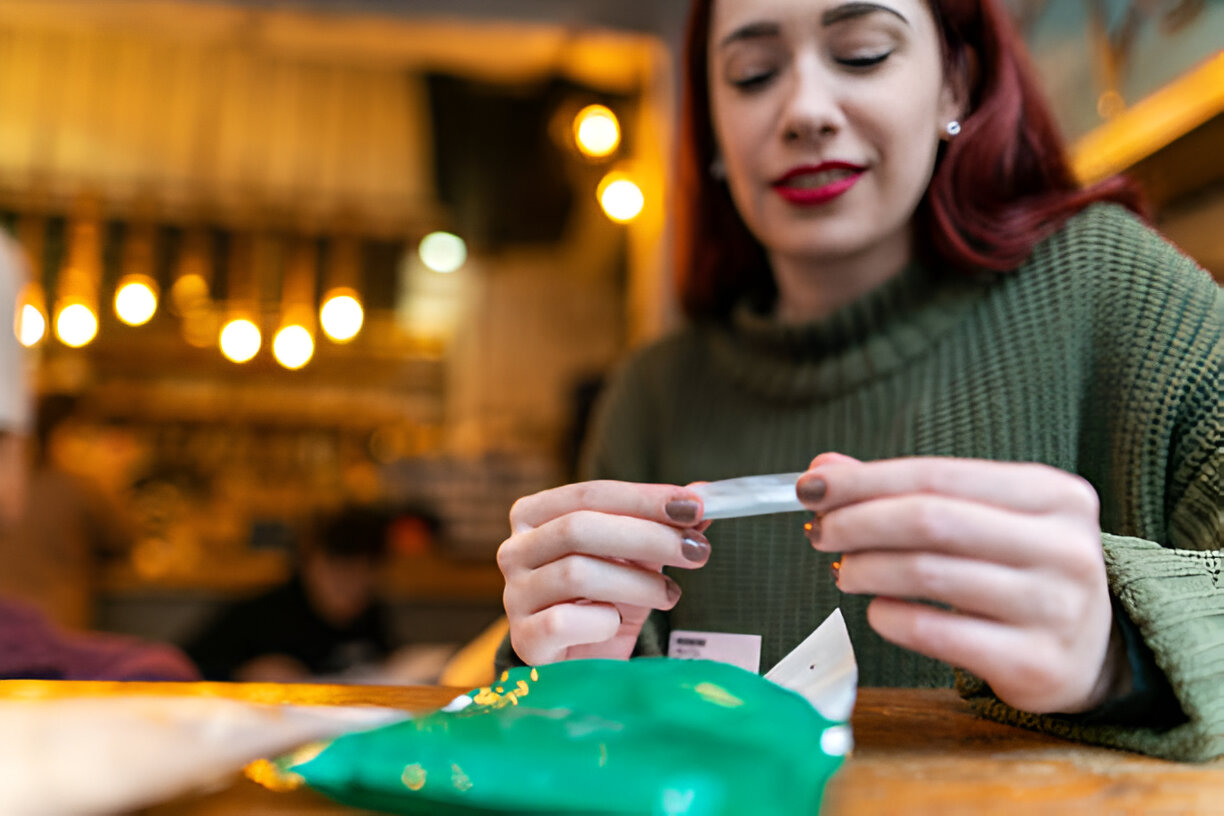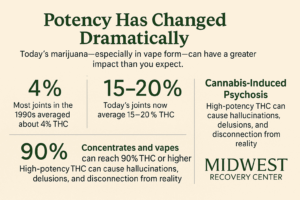You might be telling yourself, “It’s just weed. I can stop whenever I want.” Maybe you’ve even stepped away from treatment, thinking the risks weren’t really that big.
But the marijuana of today—especially in vape form—is nothing like what you remember from the 90s.
We’re not talking about the mellow, low-THC joints that floated around at parties decades ago. We’re talking about concentrated products that can quietly, quickly take a heavier toll than you expect. That’s why marijuana addiction treatment matters more now than ever.
This isn’t about scare tactics—it’s about being honest about how different the game is now, so you can make choices that protect your health, your mind, and your future.
Potency Has Changed Dramatically
In the 1990s, most joints averaged about 4% THC. Even the “strong” stuff rarely hit double digits. But today’s joints now average 15–20% THC—three to five times stronger than what was common back then.
And then there are concentrates—like those used in vape pens, dabs, and many edibles—which can reach 90% THC or higher. That’s not a small jump—it’s a complete overhaul of the product.
To put it simply:
- A few hits from a modern vape can equal what used to take dozens of joints to achieve.
- Tolerance builds faster, meaning you may need more to get the same effect in a shorter time.
- High doses hit the brain harder and can cause more intense—and sometimes unpredictable—mental effects.
Why Vapes Can Be More Harmful Than They Seem
Vapes are discreet. They don’t have the pungent smell of traditional marijuana smoke. They fit in your pocket. You can use them almost anywhere without anyone noticing.
That convenience can become a trap. With old-school smoking, the smell and ritual acted as natural speed bumps—you had to step away, light up, and be in a place where smoking was possible. With vapes, those limits disappear.
It’s easy to take a few hits before work, during lunch, or right before bed—and repeat that cycle all day without realizing how much THC you’ve consumed. Over time, you may find that it’s harder to get through any part of your day without it.
Cannabis-Induced Psychosis Is Real
One of the most serious risks of high-potency THC is Cannabis-Induced Psychosis. This is not the “mild paranoia” some people joke about—it’s a medical condition that can include:
- Hallucinations (seeing or hearing things that aren’t there)
- Delusions (believing things that aren’t true)
- Severe disconnection from reality
For some, symptoms go away after stopping marijuana use. For others, especially those with a personal or family history of mental illness, psychosis can be the start of a long-term mental health disorder, including schizophrenia.
The risk rises with:
- High THC concentrations (like those in vapes and dabs)
- Daily or near-daily use
- Early, heavy use in adolescence or young adulthood
The Hidden Impact on Your Daily Life
Even if you haven’t experienced psychosis, high-potency marijuana can quietly affect your day-to-day functioning. You might notice:
- Increased anxiety or mood swings
- Memory issues or difficulty focusing
- Less motivation for hobbies or responsibilities you used to care about
- Feeling emotionally flat or detached
Because these changes happen gradually, they’re easy to dismiss as “just stress” or “getting older.” But when you step back, you might see how much your baseline has shifted since using more potent THC products.
How This Affects Recovery
If you’ve left treatment before or taken a break, you might assume you can manage your marijuana use without much trouble. But when the product you’re using now is exponentially stronger than what you’ve known in the past, the challenges are different.
Today’s marijuana doesn’t just carry a higher risk of dependence—it can also make the emotional and mental health symptoms you were working on in treatment more severe. That’s why re-engaging in care isn’t a step backward—it’s an adjustment to a new reality.
Signs It Might Be Time to Return to Treatment
You might benefit from coming back to treatment if:
- You’re using more often than you planned, especially with vapes or concentrates
- You’ve noticed new or worsening mental health symptoms
- You’ve had moments of paranoia, confusion, or detachment after using
- Cutting back feels harder than you expected
- Friends or family have noticed changes in your mood or focus
These signs aren’t a moral failing—they’re indicators that your brain and body are struggling to keep pace with the potency and frequency of your use.
Why Local Support Matters
If you’re in or near Toledo, getting help close to home means you can keep your existing routines and support network while addressing your marijuana use. Midwest Recovery Center offers compassionate, confidential marijuana addiction treatment in Maumee, Ohio and surrounding communities.
You don’t have to disappear from your life to get help—you can start building new habits and coping strategies right where you are.
You’re Allowed to Come Back
Walking back into treatment after leaving can feel awkward. You might worry about what people will think or whether you’ll be judged for stepping away before.
Here’s the truth:
- You are welcome back at any time.
- You will not be the first or last person to take a break and return.
- The fact that you’re thinking about it now means you care about your health and future.
At Midwest Recovery Center, we meet you where you are—not where you “should” be.
FAQs About THC Vapes and Marijuana Addiction Treatment
Are THC vapes more addictive than traditional marijuana?
While the plant itself isn’t chemically addictive in the same way as opioids or nicotine, high-potency THC can lead to strong psychological dependence. The faster, more intense high from vapes makes it easier to develop that dependence.
Can vapes cause withdrawal symptoms?
Yes. People who stop heavy, regular use—especially of high-potency products—can experience irritability, sleep problems, decreased appetite, anxiety, and mood swings.
What is Cannabis-Induced Psychosis?
It’s a serious mental health condition triggered by marijuana use, particularly high doses. Symptoms include hallucinations, delusions, and severe disconnection from reality. It may resolve after stopping, but in some cases, it can persist.
Is marijuana addiction treatment only for people who want to quit completely?
No. Many programs, including ours, work with people who want to cut back, take a tolerance break, or explore whether they feel better without marijuana. The goal is to help you find the balance that works for you.
Will treatment be the same as last time?
Not necessarily. If you return to treatment, your plan will be tailored to your current needs—including addressing high-potency THC use and any new mental health symptoms.
Is it confidential if I return to treatment?
Yes. Your privacy is protected, and you control who knows about your participation.
Call (888) 657-0858 or visit Midwest Recovery Center’s marijuana addiction treatment program in Toledo, Ohio to learn more about our marijuana addiction treatment services.









